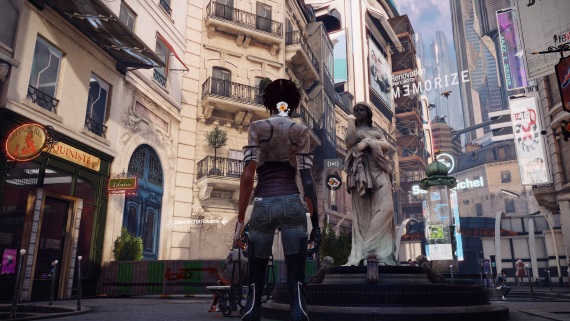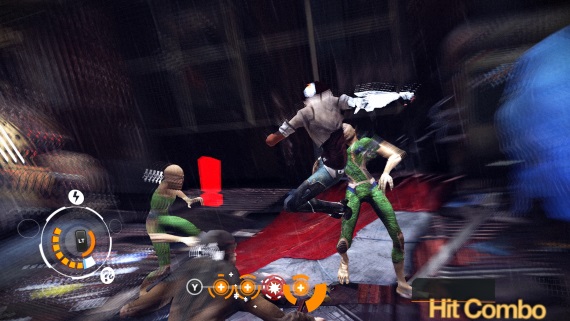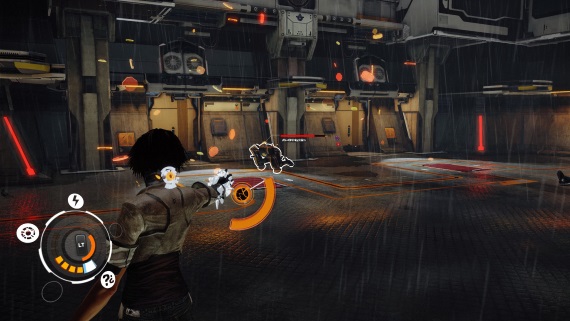
Due to GamerGate, I now pay much more attention to videogames with female protagonists than before. I find that testosterone-powered male protagonists are more likely to bore me nowadays so I’m more inclined to find games that break that mold to be more interesting. Once Remember Me got my attention, what made me decide to buy it was an intriguing story centered around memory and its memory-remixing mechanic.
- It’s a beautiful game, that is much is certain. It does get a bit on the nose about showing off just how beautiful it is. The game likes to take control of the camera for a grandiose upward sweeping view of the scenery. I also like how the augmented reality stuff like restaurant menus and names of shops and their opening hours adds detail to the environment. Most of the interior scenes are more boring, with an emphasis on a stylistic, high-tech look instead of trying to evoke real, lived-in, spaces.
- Unfortunately pretty as they are, the levels are sterile and static. You can’t talk to people, you can’t buy things from kiosks, you can’t even run into tables and knock things down. The path through them is also completely linear, which is especially frustrating given that one part of the gameplay is platforming with a decent level of parkour skills. This absolutely destroys any sense that this a world instead of a videogame level. Even worse, there is a disconnect between where you’re allowed to go and where it visually appears that you should be able to go. For example, when you’re climbing a pipe you can’t climb above a certain segment because that’s how far the designers intended you to be able to go even though visually it looks like you should be able to freely clamber up and down the whole length of the pipe.

- Another thing about the levels is how it punishes exploration. Yes, there are little secrets hidden in nooks and crannies all over the place. Unfortunately you don’t get free run of levels. Walking into each short section of the map very often closes off access to the previous section without any warning. Plus since you have no idea which direction is linear progress through the game and which section is an optional little nook, you inadvertently and permanently shut off access to bonuses and secrets simply by accidentally choosing the wrong direction. I can’t overemphasize how frustrating this is for people who like to take the time to properly explore an area.
- The combat system looks interesting enough on paper. You get a number of different fixed combos, basically different patterns of varying lengths consisting of just two buttons. But it’s up to you to populate each button-press of the combo with a “pressen” that carries a special effect. These include one that does extra damage and breaks the opponent’s guard, one that heals you, one that allows your special abilities to recharge faster and one that simply replicates whatever came before it. In practice however it’s kind of frustrating to use and actually not that deep. Even by the end of the game, you only get four different combos and I don’t think most players will be able to unlock enough pressens to actually fill out all of the combos simultaneously. So if you have a hard fight, you basically redo the combos you need for this specific fight. Some of them absolutely require spamming a special ability, so you’ll want combos that recharge them. In others you’ll want to maximize heals and so forth.
- It’s a lot of fiddling around for a combat system that frankly isn’t that much fun to play. It’s okay, I guess, but it’s lacking compared to the Batman games or even the Asassin’s Creed games. There’s no block or counter button. So it’s just hitting with one of two different attacks, a ranged attack, a dodge button which can be directionally control and a selection of special abilities. All fights also take place in what are in effect special arenas that are cordoned off for the duration of the battle, adding to the sterile and linear feel of the game. What’s worse is that the game insists on using bullshit boss fights that most modern games that smart enough to skip these days, complete with a QTE sequence at the end of each one!

- I won’t deny that the story has a number of emotional highs but on the whole it’s so preposterous and so completely centered around the main character that I can’t buy it for a moment. The theme here is obviously memory, which is a philosophically rich topic, but this story only deals with it in the most superficial of ways. There are zero surprises in the plot and I think the writers have wildly misjudged where the audience’s sympathies are as well. For my part I thought that the protagonist Nilin was evil after what she did to Olga Sedova. I thought the story would be smart enough to come back to this, but it never does. Instead, it plays it straight and we are expected to think of Nilin as being heroic.
- The worldbuilding is terrible too, going for slickness and coolness instead of any semblance of being grounded. Why the heck do guards not use guns even against terrorists who apparently have killed hundreds of people? You build a giant combat robot whose main offense is melee when your security drones can instantly zap enemies during the stealth sequences? There are lots of flavor text that you unlock but these actually reinforce how silly this world is. One technology described a system for generating power for vehicles by harnessing the kinetic energy of drops of rain! In fact, all of the tech is basically kooky magic with only the stylistic trappings of technology.
- The one really cool thing about this game are the memory remixing sequences. It’s actually very simple. You watch a short, non-interactive sequence of how a memory plays out, then you rewind back the memory and look for small, hard-coded areas where the memory can be changed. Then you watch to see how this little change affects the memory. There are a small number of these changes that you can make in each memory, and they can interact with one another. Gameplay-wise, it’s just a matter of trial and error to get the result you want but it’s fun to see how these small changes percolate to a larger effect. Unfortunately there are only four such sequences in the whole game. I can appreciate how resource-intensive it must have been to make them. Basically they have to script and create many, many versions of the same scene. But it’s still the most original and interesting part of the game and I wish there had been more of it.
Throughout the whole thing, I kept thinking that this would have been so much simpler and easier if it were just an adventure game. And indeed apparently the developers have limited themselves to this for Life is Strange, their new game. I know nothing about it other than that it is an adventure game with time-travelling elements but I suspect that’s an excuse to use the memory remixing mechanic a lot. As for Remember Me, it’s a worthy effort with some decent ideas, but ultimately I would consider it a failed one.

Leave a Reply